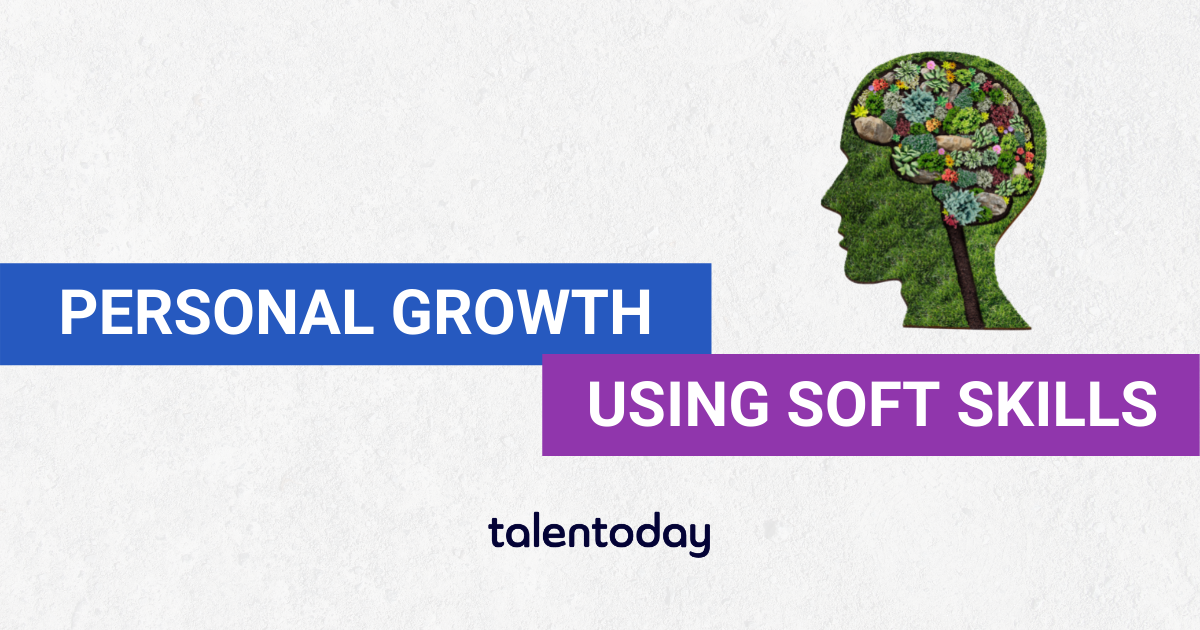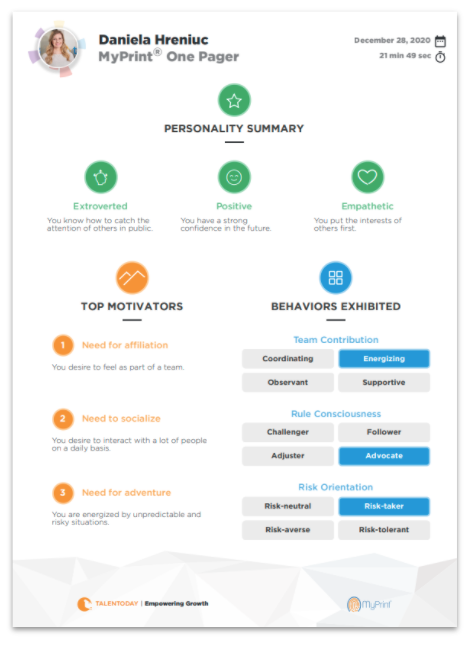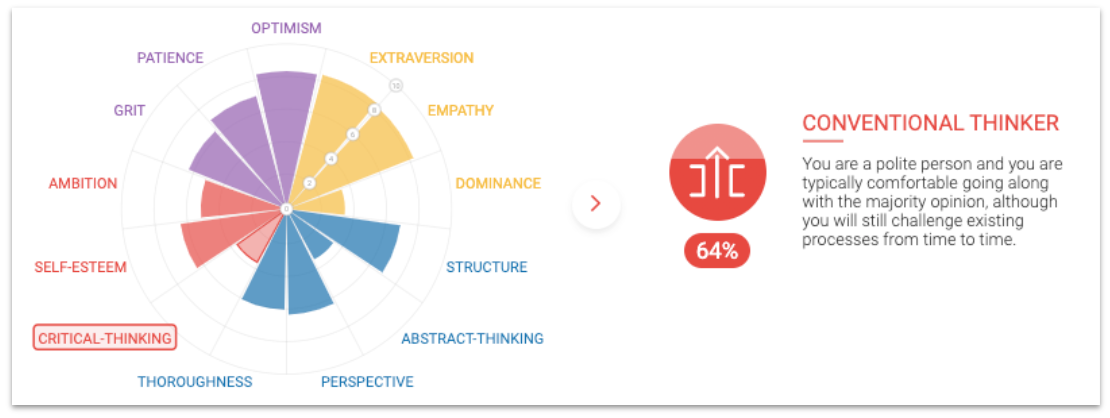Personal Growth Using Soft Skills
It’s human nature to hit a ‘reset button’ when time gives us a new beginning. That’s why gyms are the busiest on Mondays¹ and personal motivation skyrockets around birthdays². I can’t be the only person who has put off a personal goal for a couple of weeks because it’s the middle of December and January 1st is just around the corner.
Having those reset points are great for helping people set certain milestones and goals for themselves! However, self-improvement and professional development should be ongoing and not dependent on the start of a week, month, or year. There are many ways to go about continuous development: reading books or articles, finding a mentor, or watching videos and webinars are a few great places to start. Although you can take a guess at what areas you should focus on, today we are going to use science to help determine your strengths and improvement areas!
First Thing’s First: Take MyPrint®
If you haven’t taken MyPrint® already then stop reading this and take that first — it’s FREE! All you have to do is go to talentoday.com to create your free account. The assessment itself will only take about 30 minutes to complete. If you are reading this and your MyPrint® is over 6 months old we would recommend spending 30 minutes on a retake.
If you have previously taken MyPrint®, compare your two results and see what you find. Look for the areas where there is the most difference and see if you can determine what the reasons for areas of growth have been. Maybe you have had a life change, a new position, or even relate it back to the global pandemic that took over 2020 — try to pinpoint why those scores have changed.
Discover Your Strengths
Now that you have taken MyPrint®, download your One Pager (soft-skills summary). We are going to be focusing on the personality and motivations section first and then we’ll look at the personality radar in the app later on.
Take a look at your top 3 strengths in the green Personality Summary section of your One Pager. Write down unique ways that those can be useful in your current position at work or in your personal life.
Next take a look at the Top Motivators on your One Pager. Your top three motivators are listed out in orange. Determine if those needs are currently being met in your work life and if they are not, then write down some examples of how you can incorporate those into your daily work environment.
Find Your Improvement Areas
Now that we’ve looked at your strengths from the One Pager a little bit more, we’re going to go back into the app to spend some time looking at the personality radar! If you aren’t sure how to read your radar you can get an in depth overview by clicking the ‘About personality’ button in your profile.
Essentially each of the bars in the radar represents a different personality dimension. You are either towards the inside of the radar, or the outside. Although your first impression might be that the areas towards the inside of the radar are the areas that you need to grow — that is not always the case! For example, someone who needs to be providing concrete solutions to a team might struggle if they are extremely high on the ‘Abstract-Thinking’ dimension.
After you have taken some time to read your radar for a little bit, find those areas that you want to move either up or down on that radar. For example, when I look at my radar I see that my Critical-Thinking scale is a little bit lower than I would like. I am a Conventional Thinker — which isn’t bad at all! However, there are a lot of aspects in my role where I am called upon as a subject matter expert, so I want to ensure that I am not going to just go along with things because that’s what the majority wants. So this year I am going to make a conscious effort to ask more questions about the things that are presented to me so that I can get into a more naturally critical mindset.
Now it’s your turn! I can find about 4 other improvement areas when I look at my radar, but they are all based on my current work situation. Again, this doesn’t mean that I think my current soft skills are bad, it just means that I am aware that in order to grow professionally, I need to be continuously working on my development!
Put Together A Plan
Now that you know your improvement areas, focus on them! Find some books, TED Talks, or articles that you can spend time on each week to help you grow and develop. The second step here is to put together some concrete examples of how you can grow. For example, if you are a Focused individual but want to be more Big Picture — the next time you are planning out a project make a note to specifically think of that Big Picture outcome as you plan and go about your work.
Make a note of people that you work with or know who you think have those traits you are looking for. Does your manager seem to have those Critical Thinking skills that you desire? Make a note to pay attention to how she gives feedback or responds to new ideas in meetings. Maybe your coworker seems to be the most relaxed person on the planet. Take note of how he handles those times of stress and busy times.
Watch Your Growth!
Take MyPrint® again in 6 months. See how much you have grown and developed in those areas, and think of some concrete examples of how your soft skill strengths have helped you succeed in your professional life. The goal here is not to be perfect or ever be done, it is to get yourself into the mindset of continuously growing and developing your strengths.
Looking for additional resources and support? Email Talentoday at customer@talentoday.com to learn more about our assessment and services!
Sources
How to Conduct a Soft Skills Interview in 4 Easy Steps
If you have been following our blog then you know how important we think soft skills are to incorporate into your daily work lives.
“Hard skills will get you the job, but soft skills will make you successful.” -Me, at least 3 times per week
However, sometimes this can seem overwhelming. Where should you, as a manager, start? In this blog article we will take a step-by-step look at how to use soft skills from the very beginning of the employee lifecycle: the interview process.
Step 1: The Job Requirements
At first glance, you might think you know what goes into a position. Maybe you have been hiring for this position for quite some time, or you have worked with individuals in this role before. Although you might think you know all of the important requirements for a role, it is still important to take the proper steps to evaluate a job description in order to make a more informed decision on what the role entails.
Once you have determined what hard skills and qualifications are necessary for a position, it is time to determine what soft skills will help someone be successful in this role. There are many ways to find this information. Here are a few of the common ones:
It is very important that you are using a scientifically reliable and valid method to assess your teams’ soft skills. For the purpose of this article, we recommend using the MyPrint® assessment to assess your current workforce and using some of our tools available through Talentoday Manager to determine what to look for during the interview process.
An important note here: although you are looking for commonalities among your top performers, that does not mean that you want a cookie cutter of those individuals. One of the most important things for a team’s success is having diversity among group members to help fill in skills gaps and increase creativity and innovation¹.
Step 2: Preparation
Now that you have determined what the important soft skills are for the position, you need to prepare for the interview. Having a set interview process helps to ensure that you are making more informed decisions for your company and not using personal judgments or unconscious biases when hiring. Topgrading² is one example of an interview methodology that is intended to help identify top talent, and incorporating soft skills into this methodology is seamless.
Prior to the interview starting, you will also want your candidates to complete a MyPrint® assessment (check that their results are from the past 6 months to ensure accuracy). Make sure that the hiring manager and anyone involved in the interview process have taken the time to review the candidate’s MyPrint® One Pager (soft skills summary) and are familiar with the soft skills that have been determined important for the role.
To prepare for the soft skills portion of the interview, we recommend that you have the Premium Report version of the candidate’s results handy and review their top 3 personality strengths, motivators, and behaviors (as shown on the One Pager report). Then ask yourself the following questions:
Lastly, take a look at the candidate’s behaviors. The MyPrint® Premium Report has two interview questions tailored to each behavioral style to help gain a better understanding of how that individual showcases those styles. Make a note of any behaviors that you would like to dig deeper on, and have those interview questions ready to go!
Step 3: Conducting the Interview
When conducting a soft skills interview, it is important to stay open minded. If someone’s top three MyPrint® traits aren’t the exact three that you are looking for that does not mean they are not going to be a good candidate. Instead, look at their Premium Report to see where they fall on the scale for each of those traits. Take the time to ask questions around those topics, and make sure that you are being clear about the role expectations and see if that matches what they are looking for.
Step 4: Scoring the Interview
Once the interview is completed and the candidate has left, it is not time to make a decision quite yet! Take the time to review your interview notes and apply some quantitative metrics to what you were looking at.
To ensure fairness between candidates, use a standardized method of scoring the interviews. Grading methods can include ranking responses or finding the difference between ideal scores and actual scores in their MyPrint® scales.
To Sum It All Up…
Using soft skills in the interview process can help you make more informed hiring decisions, and help you find candidates who will be more successful in their role. The interview process is an investment for everyone involved, so it is not something that should be done without careful evaluation and purpose.
Remember to be open-minded when it comes to soft skills; you won’t have all of the answers right away. As you gather more information over time you will learn more about what personality traits, motivations, and behavioral styles can be attributed to success in a role and sometimes, what you find might surprise you!
Want more information about soft skill interviewing, or to receive a copy of our template? Email Talentoday at customer@talentoday.com to learn more about our assessment and services!
Sources





